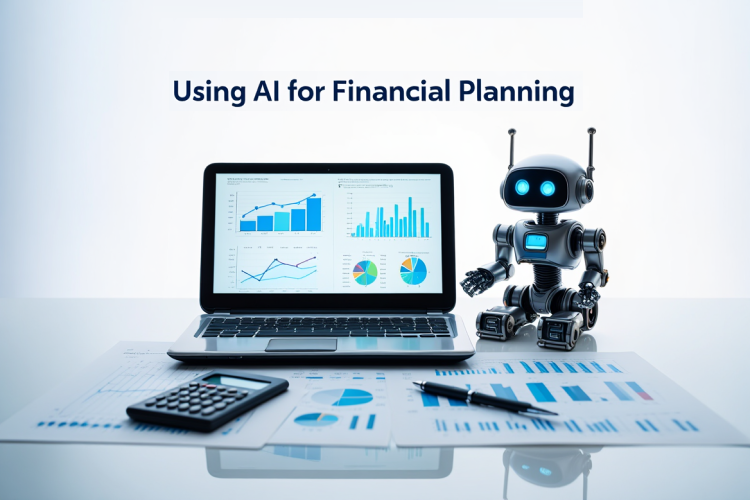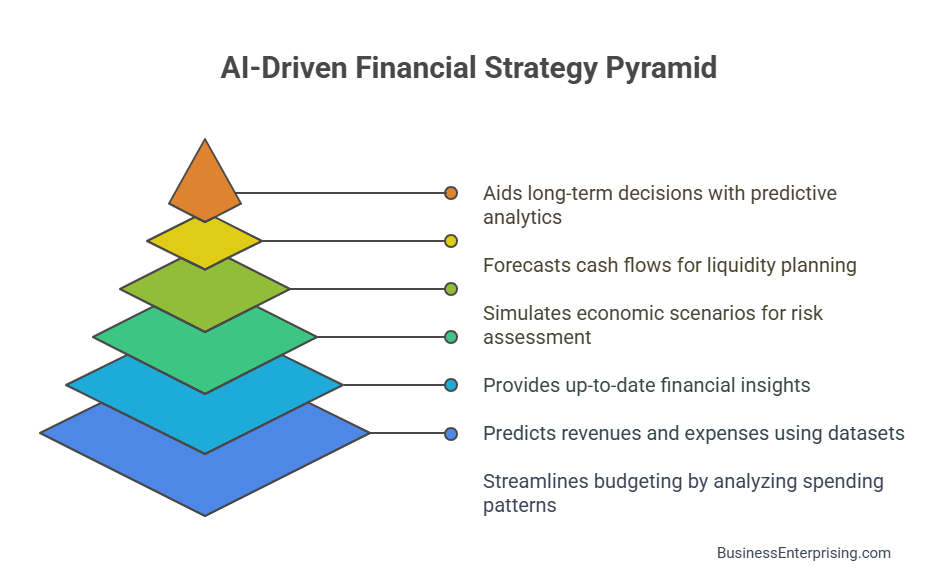
However, implementing AI in financial planning presents challenges. Ensuring data quality is crucial, as inaccuracies can lead to flawed analyses. Integration with existing systems may be complex, requiring careful planning and resources. Furthermore, the cost of AI solutions and the need for skilled personnel are significant considerations. Despite these challenges, the benefits of adopting AI in financial planning are substantial. By automating routine tasks and providing deeper insights, AI empowers you to focus on strategic initiatives. Embracing AI technology can lead to more robust financial health and a competitive edge in the marketplace.
Introduction to AI in Financial Planning
Artificial intelligence (AI) is transforming financial planning for businesses. By leveraging AI, you can analyze vast amounts of data quickly and accurately. This capability enhances financial forecasting and decision-making processes.
Traditional financial planning often involves manual data analysis, which can be time-consuming and prone to errors. In contrast, AI automates data collection and analysis, enabling real-time insights. This automation allows your finance team to focus on strategic tasks rather than routine data processing.
Moreover, AI’s predictive analytics can identify patterns and trends that might be overlooked by human analysts. For instance, machine learning algorithms can process historical and current data to forecast future financial outcomes with higher accuracy. This precision aids in budgeting, investment decisions, and risk management.
Additionally, AI facilitates scenario planning by simulating various economic conditions. These simulations help you assess potential risks and opportunities, leading to more informed strategic decisions. Consequently, using AI for financial planning enhances your organization’s agility in adapting to market changes.
Furthermore, AI-driven tools can integrate data from multiple sources, providing a comprehensive view of your financial health. This integration supports better cash flow management and financial reporting. As a result, you gain a clearer understanding of your company’s financial position.
However, implementing AI in financial planning requires careful consideration. It’s essential to ensure data quality and address potential integration challenges. Investing in training for your team is also crucial to maximize the benefits of AI tools. By addressing these factors, you can effectively harness AI’s potential to transform your financial planning processes.
AI offers significant advantages in financial planning by automating processes, enhancing accuracy, and providing deeper insights. Embracing AI can lead to more efficient operations and better-informed financial strategies for your business.
Benefits of AI-Driven Financial Forecasting
AI) is revolutionizing financial forecasting by enhancing accuracy, reducing human error, and enabling real-time data analysis. By using AI for financial planning, you can process vast amounts of data swiftly, leading to more precise financial projections.
Traditional financial forecasting methods often rely on manual data analysis, which can be time-consuming and prone to errors. In contrast, AI automates data collection and analysis, minimizing human error and allowing your finance team to focus on strategic decision-making. This automation leads to more reliable financial forecasts.
Moreover, AI enables real-time data analysis, providing up-to-date financial insights. This capability allows you to respond promptly to market changes, enhancing your organization’s agility. Consequently, AI-driven financial forecasting supports proactive decision-making and helps maintain a competitive edge.
In addition, AI’s ability to process and analyze large datasets leads to more accurate financial projections. This enhanced accuracy reduces the likelihood of costly financial missteps and supports more informed strategic planning. Therefore, integrating AI into your financial forecasting processes can significantly improve your organization’s financial performance.
Furthermore, AI can identify patterns and trends that may not be apparent through traditional analysis. This deeper insight allows for better anticipation of market shifts and potential risks. As a result, AI-driven forecasting enhances your organization’s ability to navigate complex financial landscapes effectively.
However, it’s essential to recognize that AI is a tool that complements human expertise. While AI can process data and identify patterns efficiently, your team’s strategic insights and judgment remain crucial. Therefore, combining AI capabilities with human expertise leads to the most effective financial forecasting outcomes.
AI Tools and Technologies for Financial Planning
AI is revolutionizing financial planning by offering advanced tools for budgeting, forecasting, cash flow management, and risk analysis. By using AI for financial planning, you can enhance accuracy and efficiency in these critical areas.One notable AI-powered platform is Drivetrain, which provides dynamic financial modeling and planning. It offers real-time insights that help optimize financial operations, making budgeting and forecasting more precise.
Another prominent tool is Anaplan, designed for enterprise-level financial planning. Anaplan integrates various financial processes, enabling seamless budgeting, forecasting, and scenario analysis. Its AI capabilities facilitate data-driven decision-making. For cash flow management, HighRadius offers AI-driven forecasting software that automates daily cash projections. It predicts cash flows with up to 95% accuracy, aiding in effective liquidity management. In the realm of risk analysis, Riskalyze provides tools to assess investment risk and align portfolios with clients’ risk tolerance. Its AI-driven platform helps financial advisors make informed decisions. Additionally, Datarails is a financial planning and analysis platform that automates data consolidation and reporting. It enhances budgeting and forecasting accuracy by integrating data from multiple sources.
Implementing these AI-powered tools can transform your financial planning processes. They not only improve accuracy but also reduce manual efforts, allowing your team to focus on strategic initiatives. However, it’s essential to choose platforms that align with your organization’s specific needs and ensure proper integration with existing systems. By embracing AI technologies in financial planning, you position your organization for greater agility and informed decision-making. This adoption leads to more robust financial health and a competitive edge in the market.
Data Integration and Automation Capabilities
AI is transforming financial planning by automating data integration and analysis. By using AI for financial planning, you can streamline processes and enhance decision-making.
Traditionally, financial planning involves manual data gathering from various sources, which can be time-consuming and error-prone. However, AI automates this process, collecting data from multiple financial platforms seamlessly. This automation reduces the risk of human error and ensures data accuracy. Consequently, your team can focus more on strategic tasks rather than mundane data collection.
Moreover, AI doesn’t just gather data; it also analyzes and interprets it in real-time. This capability allows for immediate insights into financial performance, enabling prompt responses to emerging trends or issues. For instance, AI can detect anomalies in cash flow patterns, alerting you to potential problems before they escalate. Therefore, integrating AI into your financial planning enhances your ability to make informed decisions swiftly.
Additionally, AI’s predictive analytics can forecast future financial scenarios based on historical and current data. These forecasts assist in budgeting, investment planning, and risk management. By anticipating potential financial outcomes, you can develop strategies to mitigate risks and capitalize on opportunities. Thus, AI empowers you to plan proactively rather than reactively.
However, implementing AI requires careful consideration of data privacy and security. It’s essential to ensure that AI systems comply with relevant regulations and protect sensitive financial information. Additionally, integrating AI into existing systems may present challenges that require technical expertise. Therefore, a thoughtful approach to AI adoption is necessary to maximize its benefits while minimizing potential risks.
Incorporating AI into your financial planning processes offers significant advantages. By automating data integration and analysis, AI enhances accuracy, efficiency, and strategic decision-making. Embracing AI technology can lead to more robust financial health and a competitive edge in the marketplace.
AI for Scenario Analysis and Risk Management
AI is also transforming financial planning by enhancing scenario analysis and risk management. By using AI for financial planning, you can simulate various economic scenarios and prepare for financial uncertainties.
Traditional scenario analysis often relies on manual processes, which can be time-consuming and limited in scope. However, AI automates this process, enabling real-time, scalable forecasting. For instance, AI-driven tools can process vast datasets and generate thousands of possible outcomes within seconds. This capability allows you to assess potential risks and opportunities more efficiently.
Moreover, AI enhances accuracy in risk identification. It reduces human bias by identifying patterns and relationships that may not be immediately obvious. For example, banks use AI-powered scenario analysis to stress test loan portfolios under different economic conditions. By modeling interest rate changes, credit risk fluctuations, and macroeconomic downturns, you can make proactive adjustments to risk exposure.
Additionally, AI’s predictive analytics capabilities help assess and manage financial risks. This technology makes it easier to determine the risk associated with loans, investments, or trading. By analyzing vast datasets and uncovering hidden patterns, AI helps organizations predict future financial outcomes more accurately, reduce risks, and unlock new opportunities.
Furthermore, AI facilitates continuous risk assessment and compliance automation. AI-powered tools enable finance professionals to analyze complex financial flows in real time, surface hidden risks, and optimize planning with predictive intelligence. From continuous risk assessment to compliance automation and smarter investment strategies, AI is redefining how financial leaders operate.
However, implementing AI in scenario analysis requires careful consideration. It’s essential to ensure data quality and address potential integration challenges. Investing in training for your team is also important to maximize the benefits of AI tools. By addressing these factors, you can effectively harness AI’s potential to transform your scenario analysis and risk management processes.
Challenges and Considerations When Implementing AI
Implementing artificial intelligence (AI) in financial planning offers numerous advantages, but it also presents several challenges that you should consider. One significant obstacle is data quality. AI systems rely on accurate, consistent data to function effectively. However, integrating data from diverse sources can lead to inconsistencies and inaccuracies. These issues can compromise the reliability of AI-driven insights.
Integration complexity is another concern. Many organizations operate legacy systems that may not be compatible with modern AI technologies. This incompatibility can make seamless integration challenging. Addressing these complexities requires careful planning and execution to ensure AI tools work harmoniously with existing infrastructure.
Cost considerations also play a crucial role. Implementing AI involves significant financial investment, including acquiring technology, managing data, and hiring skilled personnel. These expenses can escalate, especially as AI usage grows within your organization. Therefore, it’s essential to conduct a comprehensive cost-benefit analysis before adopting AI solutions.
Moreover, there’s a notable shortage of professionals with expertise in both AI and finance. This skills gap can hinder the effective implementation of AI initiatives. Investing in training and development for your existing team or recruiting new talent with the necessary skills is vital to bridge this gap.
Additionally, ethical and regulatory considerations cannot be overlooked. AI systems must comply with data privacy laws and operate transparently to maintain trust. Ensuring your AI applications adhere to these standards is essential for responsible usage.
Incorporating AI into your financial planning processes requires thoughtful consideration of these challenges. By addressing data quality, integration complexity, costs, and skill requirements, you can effectively harness the benefits of using AI for financial planning while mitigating potential risks.
Conclusion
Integrating artificial intelligence (AI) into your financial planning processes offers significant advantages. By automating data analysis, AI provides more accurate forecasts and enhances decision-making. This technology enables real-time scenario analysis, allowing you to anticipate market shifts and adjust strategies accordingly. Additionally, AI streamlines budgeting and cash flow management, reducing manual errors and increasing efficiency.
However, adopting AI also presents challenges. Ensuring data quality is essential, as inaccurate information can lead to flawed insights. Integration with existing systems may be complex, requiring careful planning and resources. Moreover, the cost of implementing AI solutions can be substantial, encompassing both technology acquisition and personnel training. Therefore, it’s crucial to assess the return on investment when considering AI adoption.
Furthermore, the need for skilled professionals to manage and interpret AI outputs cannot be overlooked. Investing in training your team or hiring experts is vital to fully leverage AI’s potential. Addressing these considerations thoughtfully will position your organization to reap the benefits of using AI for financial planning. By balancing technological advancements with strategic planning, you can navigate the complexities and enhance your financial operations effectively.



